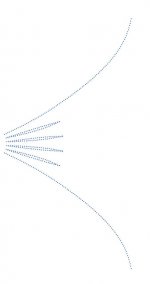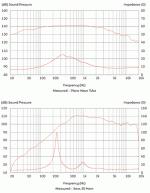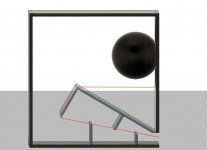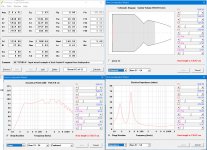There's isn't much that isn't worth a try if you have the time to do itWhat do you think is telling and about which dip?
What I see in the impedance traces shows what I was trying to tell you before, the resonant frequency hasn't changed all that much between the two, it is more highly damped and spread out on the PWT measurement. Any practical horn is going to look much more like the seos measurement than the PWT.
I have seen a lot of ABEC simulations of different baffle treatments and they all show that taking care of the transition from speaker to baffle and the edge of the baffle makes a big difference in reducing diffraction. This is the reason Earl Geddes does not like unbaffled horns, even with a massive rollback the other edges nearby create sources of diffraction that a straight out simulation of the horn will not show. Changing slowly from one point to another as smoothly as possible is the goal. Angled faceted baffles can get surprisingly close to a big radius and are much easier to construct out of wood if you have the tools, or cheaper to have someone else make for you.
Making all the parts out of a 3D printer and getting them to be straight and accurate is an extremely difficult task. If it was me I would be looking for a hybrid construction to make that task easier.
Well as soon as I did it I was reminded that I have no idea what the excursion is doing or what xmax is, so my prediction doesn't mean much but I did feel like Impedance wise, I am in there for a successful crossover anywhere as long as excursion permits....If I remember correctly I will test this with low levels and visual inspection of THD...
Also, why do you say that impedance is more damped on PWT, Impedance is lower on the horn, much lower in the areas above resonance.
Have you used a 3d printer, they are "easily" printing objects much more complicated than the needs of audio, there is a margin for error for things like the surface of a horn or a baffle. I'm not sure what you'd do if you where me....I was just looking at a pair of EgglestonWorks Andra I....I think the slant on the edges is easy to copy. What do you think?
Attachments
Last edited:
Sarcasm.....you guys probably don't like Dave Chapel either....in other words, don't be bothered by that, it wasn't meant to be tooken to heart.
Because it isAlso, why do you say that impedance is more damped on PWT, Impedance is lower on the horn, much lower in the areas above resonance.
No I have not because I have not seen anyone make anything with them that interests me at a price I could afford. I have bought a CNC machine for this sort of thing, although making a horn like you intend is quite an undertaking out of any material. If you think it is easy then I am eager to see what you produce.Have you used a 3d printer, they are "easily" printing objects much more complicated than the needs of audio, there is a margin for error for things like the surface of a horn or a baffle. I'm not sure what you'd do if you where me....I was just looking at a pair of EgglestonWorks Andra I....I think the slant on the edges is easy to copy. What do you think?
That Egglestone works speaker is not a good example of diffraction reduction techniques, design over engineering.
Have a look at this from Alexander Heissman, not horns but the principle is the same
Basic article | Baffle geometry
Hi!
I have a paier of these in raw multiplex
The opening at throat is about 40mm x 51mm. For a 2" driver there is a compression vertical wise what I do not like. For my 1.5" this is a good fit. This horn loads appromimately down to about 300-350Hz but cross-over should be considerably higher.
I have designed a new longer adapter which provides a better and more even loading to the driver. Ahh, I forgot - loading is not relevant for home use
I have a paier of these in raw multiplex
The opening at throat is about 40mm x 51mm. For a 2" driver there is a compression vertical wise what I do not like. For my 1.5" this is a good fit. This horn loads appromimately down to about 300-350Hz but cross-over should be considerably higher.
I have designed a new longer adapter which provides a better and more even loading to the driver. Ahh, I forgot - loading is not relevant for home use
Hi!
I have a paier of these in raw multiplex
The opening at throat is about 40mm x 51mm. For a 2" driver there is a compression vertical wise what I do not like. For my 1.5" this is a good fit. This horn loads appromimately down to about 300-350Hz but cross-over should be considerably higher.
I have designed a new longer adapter which provides a better and more even loading to the driver. Ahh, I forgot - loading is not relevant for home use
In the meantime I have my own calculator for this type of horns. Very flexibel with any opening angle or number of fins. The TH4001 has staright side walls which I think is not optimal. Here is an example of my new approach:

not sure if posted before but thought of a ceramic driver 2 way that wd cover most of spectrum, maybe not high spl
Peerless ceramic tweeter (32mm) in shallow guide and SB Acoustics CAC 8" 4 ohm, crossed around 1.6khz
guessing it wd be fairly neutral sounding
Interesting, and speaking of ceramics, I've been wondering about Zirconia Toughened Alumina (ZTA) diaphrams. This material features some desirable properties, notably a Young's Modulus of >300 (GPa) at a slightly lower density than Titanium.
Last edited:
Or at least thats what I'd like to think, I'd take 250hz tbh, 150hz would be better =)
Then what's the holdup? I mean it's just a matter of size and if too big, truncate it and make a [4] driver throat adapter, once a huge challenge, but judging by some the horn designs being pumped out lately, surely the program
GM
Last edited:
Then what's the holdup? I mean it's just a matter of size and if too big, truncate it and make a [4] driver throat adapter, once a huge challenge, but judging by some the horn designs being pumped out lately, surely the programcan sim, 3D model make adapters like the pioneers likely couldn't even envision.
GM
Do I need 4? Maybe 2 will work? I’m not going to pretend I know the challenge of designing this, or tuning it but where there’s a will there’s a way. If I could get the 15m the Axi and another driver to play super tweet, to come out of the same polar axis, like a unity, that’d be something. If I could get down there with 2 axis on one horn,, that’d be something
not sure if posted before but thought of a ceramic driver 2 way that wd cover most of spectrum, maybe not high spl
Peerless ceramic tweeter (32mm) in shallow guide and SB Acoustics CAC 8" 4 ohm, crossed around 1.6khz
guessing it wd be fairly neutral sounding
I have SB17CAC, 6.5'' woofer and SB26CDC, both have ceramic cone sandwich. And maybe it would cover from 35Hz to 20k at low SPL.
Ok here’s a good question, I think.
Where does wall, corner, and floor loading fit in the spectrum of time domain performance. Potentially Sealed is the best performing in this area because the sound isn’t coming from 2 sources like a port and driver. Outside of that how does plane loading perform. I read that keeping a front facing port within 3 inches of the ground cause a strong loading affect. Looking at the ariels a down firing port is executed. I tend to favor front firing as being more accurate but an I mistaken?
Where does wall, corner, and floor loading fit in the spectrum of time domain performance. Potentially Sealed is the best performing in this area because the sound isn’t coming from 2 sources like a port and driver. Outside of that how does plane loading perform. I read that keeping a front facing port within 3 inches of the ground cause a strong loading affect. Looking at the ariels a down firing port is executed. I tend to favor front firing as being more accurate but an I mistaken?
In a Synergy the highest frequencies need to come from the end of the horn, if going down that road then it doesn't make as much sense to use the Axi-Driver when any number of 2" CD's would get down to a low enough point to cross to the 15's. That has been shown to work very well on a big enough horn to house the 15's like Chris's K402 MEH.If I could get the 15m the Axi and another driver to play super tweet, to come out of the same polar axis, like a unity, that’d be something. If I could get down there with 2 axis on one horn,, that’d be something
Downfiring allows the designer to know with more certainly how the port will react with it's environment as another variable is taken out of the equation. As long as they are more than 3 or 4 times the diameter of the port away from any surface they should perform the same. Accurate is a relative term when referring to time domain performance and vented cabinetsI tend to favor front firing as being more accurate but an I mistaken?
The closer the port to the listener, the tighter the group delay. Group delay isn't such an issue at lower notes so....Accurate is a relative term
Do I want a downfacing port? Is there a disadvantage?
Maybe. The benefits of a low cross over are still had no matter if its coaxial or not. Maybe I can put the 15 in a small sealed box with the driver facing upwards into another box hosing the horn, with the holes in horn...I don't know the formula for the synergy.if going down that road then it doesn't make as much sense to use the Axi-Driver
Repeating this shajt still kind of validate and accept it. Eye wink or not (you didn't).
//
How does one calculate the position of the vent along the horn?
nothing to calculate;
close to the mouth and in the corners is best
So all I have to do is put a hole(s) in the horn near the mouth? Maybe model the holes as port from a cavity like a bandpass?
- Home
- Loudspeakers
- Multi-Way
- Is it possible to cover the whole spectrum, high SPL, low distortion with a 2-way?



